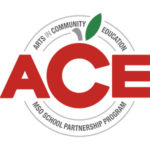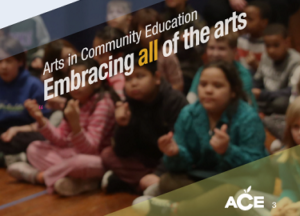
Arts Impact
Research proves high quality art based educational opportunities contribute to student success and equity by fostering improved scholastic achievement in literacy, math, and critical thinking in addition to helping students gain valuable perspectives on diverse cultures and contributing to improved behavior.
The Benefits of Arts Education
- Research suggests that school-community arts partnerships improve academic achievement and attainment.
- Arts integrated education is correlated with improved academic outcomes that are especially significant in underserved populations.
- Music education strengthens math and reading skills, especially in young learners.
- Music education has been shown to improve IQ signifiers, such as critical thinking and capacity to process and relate complex concepts and ideas.
- Arts learning experiences develop student self-expression, creativity, and empathy.
- Arts learning enhances cognitive abilities which foster critical thinking skills.
- Arts exposure increases student tolerance, historical empathy, and ability to think critically about works of art.
- Evidence suggests involvement in the arts improves students’ academic outcomes and memory of learning events.
- Arts integration pedagogy benefits struggling readers to a greater degree than proficient and advanced readers, and is an especially powerful tool to meaningfully engage English as a second language learners, early learners, and when instructing groups of students from diverse ethnic/racial and socioeconomic backgrounds.
(Moreno et al., 2011; Neville, 2008; Schellenberg, 2004; Gromko, 2005; Lee & Kim, 2006; Moreno et al., 2009; Standley, 2008; Bowen, Greene, & Kisida, 2014; Greene, Kisida, & Bowen, 2014; Kisida, Bowen, & Greene; 2016; Catterall & Waldorf, 1999; Dewey, 1919; Ruppert, 2006; Zimmerman, 2009; Eisner, 2002; Hardiman, Mahinda JohnBull, Carran, Shelton, 2019; Robinson 2013; Peppler, Powell, Thompson, Catterall, 2014; Scripps, Paradis, 2014; Caterall, 2012; Hardiman, Rinne, Yarmolinksaya, 2014; Smith, O’Brien, 2016; Rinne, Gregory, Yarmolinskaya, Hardiman, 2011; O’Donnell, 2008).
The Necessity of Access to Arts Education
- Arts education offerings have steadily declined since the 1980’s for low income students.
- Students identifying as African-American have experienced reductions of 49%, and there has been a 40% decline for students identifying as Hispanic/Latinx.
- Children whose parents have less than a high school education experienced a 77 percent decline in arts access.
- Students’ race, ethnicity, and/or residence in neighborhoods with low socioeconomic status are strong predictors related to arts access opportunities, with the historically underserved populations above receiving substantially less exposure to high quality arts opportunities.
- Historically-underserved students demonstrate more-pronounced, positive impacts from school-sponsored arts exposures, suggesting these interventions reduce gaps in educational outcomes.
(Hamilton et al., 2007; Rabkin & Hedberg, 2011; von Zastrow & Janc, 2004; West, 2007; Kisida, Greene, & Bowen, 2014; Meyer, Princiotta, & Lanahan, 2004; Redford, Burns, & Hall, 2018; Kisida, Greene, & Bowen, 2014; Meyer, Princiotta, & Lanahan, 2004; Redford, Burns, & Hall, 2018; Catterall, Dumais, & Hampden-Thompson, 2012; Kinney & Forsythe, 2004; Kisida, Greene, & Bowen, 2014; Podlozny, 2000; Thomas, Singh, & Klopfenstein, 2015)
Interested in learning more about the Arts in Community Education program?
Click the button below to fill out the ACE interest form.
Get Started
Backstage Pass
Be first to know about our concerts, special sales and MSO news—sign up for our e-newsletter.
SubscribeVolunteer
Interested in becoming more involved in education events? Find out more about volunteer opportunities with the Milwaukee Symphony.
Get StartedDonate Now - Education
Help support the Milwaukee Symphony Orchestra’s education programs and initiatives. Select MSO Education as your type of gift when submitting a donation.
Donate Now
